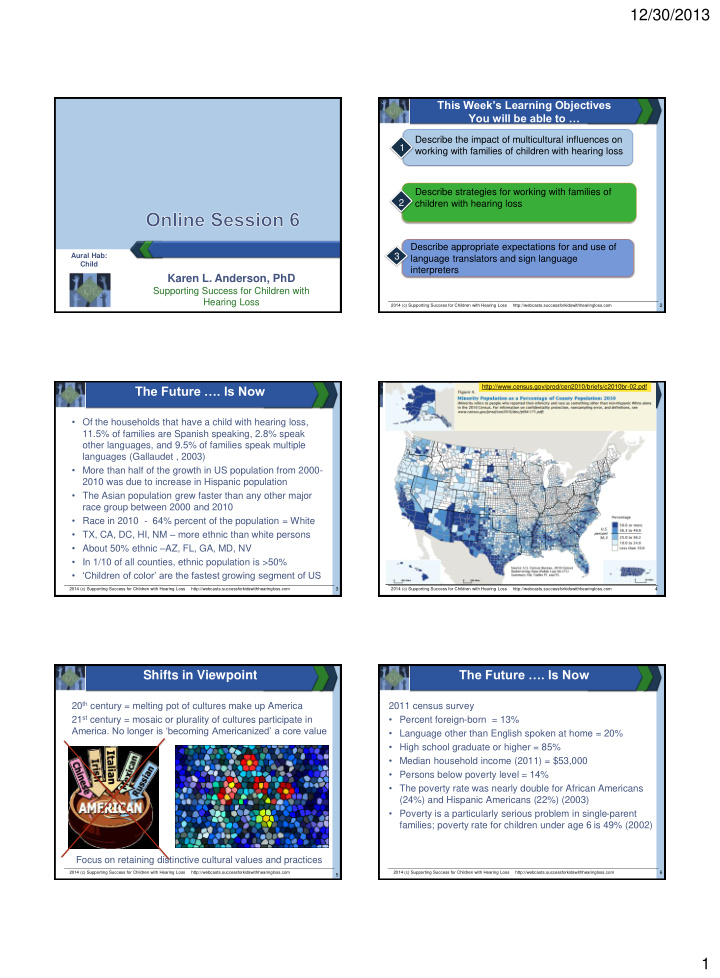



12/30/2013 This Week’s Learning Objectives You will be able to … Describe the impact of multicultural influences on 1 working with families of children with hearing loss Describe strategies for working with families of 2 children with hearing loss Describe appropriate expectations for and use of Aural Hab: 3 language translators and sign language Child interpreters Karen L. Anderson, PhD Supporting Success for Children with Hearing Loss 2014 (c) Supporting Success for Children with Hearing Loss http://webcasts.successforkidswithhearingloss.com 2 http://www.census.gov/prod/cen2010/briefs/c2010br-02.pdf The Future …. Is Now • Of the households that have a child with hearing loss, 11.5% of families are Spanish speaking, 2.8% speak other languages, and 9.5% of families speak multiple languages (Gallaudet , 2003) • More than half of the growth in US population from 2000- 2010 was due to increase in Hispanic population • The Asian population grew faster than any other major race group between 2000 and 2010 • Race in 2010 - 64% percent of the population = White • TX, CA, DC, HI, NM – more ethnic than white persons • About 50% ethnic – AZ, FL, GA, MD, NV • In 1/10 of all counties, ethnic population is >50% • ‘Children of color’ are the fastest growing segment of US 2014 (c) Supporting Success for Children with Hearing Loss http://webcasts.successforkidswithhearingloss.com 3 2014 (c) Supporting Success for Children with Hearing Loss http://webcasts.successforkidswithhearingloss.com 4 The Future …. Is Now Shifts in Viewpoint 20 th century = melting pot of cultures make up America 2011 census survey • Percent foreign-born = 13% 21 st century = mosaic or plurality of cultures participate in America. No longer is ‘becoming Americanized’ a core value • Language other than English spoken at home = 20% • High school graduate or higher = 85% • Median household income (2011) = $53,000 • Persons below poverty level = 14% • The poverty rate was nearly double for African Americans (24%) and Hispanic Americans (22%) (2003) • Poverty is a particularly serious problem in single-parent families; poverty rate for children under age 6 is 49% (2002) Focus on retaining distinctive cultural values and practices 2014 (c) Supporting Success for Children with Hearing Loss http://webcasts.successforkidswithhearingloss.com 2014 (c) Supporting Success for Children with Hearing Loss http://webcasts.successforkidswithhearingloss.com 6 5 1
12/30/2013 Poverty Family Structure • Living in poverty makes children more vulnerable to • 25+% of children are raised in single parent homes hearing loss and associated disabilities, as they often • 3+% of children are adopted (often from outside of US) face inadequate medical care, higher rates of recurrent • In general, less stable home dynamics becoming more serous otitis media, lead poisoning, and poor nutrition. common in the US, especially among single-parent and • The needs of low-income caregivers are great, as their ethnic households parenting behaviors are mediated by their psychological • Having a child with a disability increases risk of divorce well-being and literacy. • Poverty may also limit children’s access Due to the preference of many ethnic groups for to stimulating learning environments. consanguineous marriages and the smaller pool of • A low-income family, struggling to provide basic available partners, children of color often exhibit a necessities, may have little time or resources to higher rate of inherited disabilities, including hearing devote to advocating on behalf of their child or teaching loss. their child how to listen, speak, and read. 2014 (c) Supporting Success for Children with Hearing Loss http://webcasts.successforkidswithhearingloss.com 7 2014 (c) Supporting Success for Children with Hearing Loss http://webcasts.successforkidswithhearingloss.com 8 Moms who are Kids Increasing numbers • The high rate of immigration from developing countries, where hearing loss is more prevalent, is leading to a growing number of children with special needs that 5.2% 5.6% do not share the same culture of 3.4% most auditory-based clinicians. • In order to meet the challenges of a multicultural society, professionals working with children who are deaf or hard of hearing will need to develop the skills and knowledge to manage diversity effectively. http://www.cdc.gov/nchs/data/databriefs/db89.pdf 2014 (c) Supporting Success for Children with Hearing Loss http://webcasts.successforkidswithhearingloss.com 9 2014 (c) Supporting Success for Children with Hearing Loss http://webcasts.successforkidswithhearingloss.com 10 Sociocultural Mismatches … Bias • We all have biases • Lack of knowledge about health beliefs and life • May include race, ethnicity, age, weight, gender, etc. experiences • Bias has the strongest effects when it comes to what • May bring unintentional or intentional racism, classism, healthcare providers don’t do for some patients. homophobia, or sexism to the interaction e.g., Not pursuing referrals, devices, support as promptly or • • Expectations vary by ethnicity, SES status, prior thoroughly. experience, setting, etc. Example: • Also impacts how patients/families view YOU as a Audiologist meets a client for the first evaluation session and clinician and their willingness to work with you. immediately begins to ask questions, so as to quickly complete the e.g., African American SLP being turned away from home health interview and record all necessary health history information. Then • services because “We don’t allow Negros in our house!”; being goes on to test the client and subsequently bids her farewell. called the Speech Aide rather than recognized as the SLP There has been no encouragement for the patient to voice e.g., Latino clinician “I have to be perfect, speak perfectly and • his/her concerns and perspectives regarding hearing present myself in the best light.” needs. Impact of hearing issues on life. Expectations for e.g., Ageism – “You are so young, how can you understand.” • evaluation appointment, etc. Preconceived notions – > bias. “You aren’t a mother. You can’t possibly understand.” 2014 (c) Supporting Success for Children with Hearing Loss http://webcasts.successforkidswithhearingloss.com 11 2014 (c) Supporting Success for Children with Hearing Loss http://webcasts.successforkidswithhearingloss.com 12 2
Recommend
More recommend